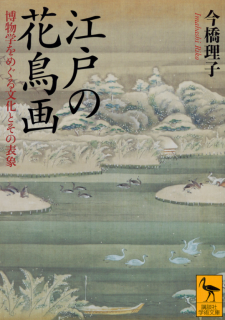Japanese Bird-and-Flower Paintings:
The Intersection between Natural History and Visual Culture in the Edo Period
Review of Riko Imahashi, Edo no Kachōga. Tokyo: Kodansha, 2017
今橋理子『江戸の花鳥画:博物学をめぐる文化とその表象』
東京:講談社学術文庫、2017年

https://bookclub.kodansha.co.jp/product?item=0000211892
Since ancient times, Japanese people have cultivated an aesthetic sensitivity in their relationship to the natural world. To portray the varied aspects of nature, diverse representations of plants and animals emerged in literature, performing arts and visual culture. Since its introduction from China, probably in the fourteenth century, “bird-and-flower painting” (Kachōga) has been a common genre in Japanese art, depicting myriad aspects of the natural world. Yet, belying the literal meaning of its name, “bird-and-flower painting” features a broad variety of subjects including animals other than birds and plants other than flowers, as well as insects and natural landscapes. In fact, anything related to the natural world is a potential object for visual representation.
Riko Imahashi explores Japanese bird-and-flower paintings in the eighteenth and nineteenth centuries to examine the intersection between natural history and visual culture during the Edo period. In addition to professional artists, samurai (including feudal lords) sometimes became amateur artists, sketching and copying bird-and-flower paintings. In urban areas, there were also several shows featuring exotic animals such as parrots that attracted local merchants and craftsmen. This widespread presence of bird-and-flower painting acts as a clue to understand how Japanese people during this period both grasped and represented the natural world. Similar to the pioneering natural historians in eighteenth-century Britain, who depicted and collected natural drawings in an effort to understand plants and animals, these people in Japan also inquired into and attempted to represent the natural world.
This synchronicity, the nearly contemporaneous rise of natural history and its aesthetic representations in two distant regions, is not entirely a coincidence. Some Japanese artists including Odano Naotake (1749-80) encountered European books and objects, which transformed their understanding and way of visual representation. Imahashi’s study of various bird-and-flower paintings reveals the existence of a wide circulation of knowledge and materials connecting Europe and Asia at the time, and that the interaction between different intellectual traditions promoted the formation of new understandings and representations of the natural world during the Edo period. Odano was one of the pioneering figures in the history of Japanese art who aimed to merge the East Asian tradition of visual arts and European thinking on natural philosophy. The visual culture of eighteenth-century Japan shows that Japanese people had some channels for intellectual exchange and intercultural experience beyond their own country, yet these encounters were indirect and mediated by objects.
There were also remarkable Japanese artists who developed their own ideas and representations of the natural world based solely on the Japanese intellectual tradition, without knowledge of European arts and learning. Itō Jakuchū (1716-1800), whose “Colorful Realms of Living Beings” is a masterpiece of Japanese bird-and-flower painting, chose roosters and hens as his favorite visual motif. Thanks to the “Colorful Realm: Japanese Bird-and-Flower Paintings by Itō Jakuchū” exhibition (2012) at the National Gallery of Art in Washington D.C., his name and works have become more well-known in the Anglophone world. His “White Cockatoo” (circa 1755) is available to the public via the online collection of Yale University’s Art Gallery.[1]
The final part of Imahashi’s monograph focuses on bird-and-flower painting in ukiyo-e and includes the works of Suzuki Harunobu (circa 1725-70), Kitagawa Utamaro (1753-1806) and Utagawa Hiroshige (1797-1858). This intellectual exploration shows the process through which Japanese thought on natural history was incorporated into the popular culture of the Edo period. These ukiyo-e artists carefully observed the natural world and developed their own individual ways of visual representation through interacting with other forms of knowledge and expression including botanical studies and herbal medicine (“honzō-gaku”) represented by Kaibara Ekiken (1630-1714), as well as Japanese literature and East Asian classics. For instance, Haiku poets employed animals and plants as favored motifs and sometimes added illustrations to their literary work, leading to a series of remarkable collaborations between literary expression and visual representation through which the portrayal of animals and plants became a distinct motif in ukiyo-e.
Imahashi highlights the crucial function of visual culture in the rise of natural history during the Edo period. She details this process by focusing on the intellectual curiosity of Japanese artists who incorporated various forms of knowledge and representation to depict the natural world in distinctive ways. In reading her monograph, we are also invited to think about the rise of natural history in Europe from a comparative perspective. Her study will benefit those who are interested in the use of visual materials in their interdisciplinary approach to eighteenth and nineteenth century studies, as well as those who aim to explore any global aspect of visual culture or intellectual history. Her discussion will attract readers who may have little knowledge of Japanese art, or even Japan in general.
Yusuke Wakazawa (EAA Project Research Fellow)
[1] https://artgallery.yale.edu/collections/objects/111556








